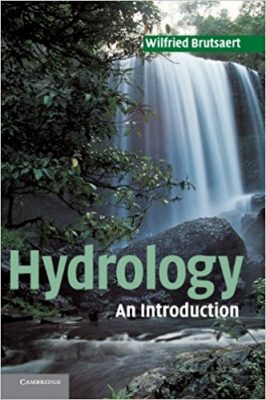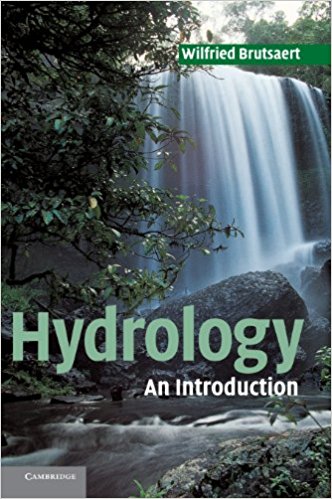 Author: Wilfried Brutsaert
Author: Wilfried Brutsaert
Publisher: Cambridge University Press – 605 pages
Book Review by: Sonu Chandiram
We all know that water is essential to our survival, and it is the most precious resource we can ever have. But “water in its different forms has always been a source of wonder, curiosity, and practical concern for humans everywhere,” the author Wilfried Brutsaert points out in his Introduction.
Beyond seeing that water comes to us in the form of rain (and snow, sleet, hale, etc.) and fills our reservoirs, have you wondered what happens next, such as on the distribution and transport of water in our natural environment, and into and within our cities and towns? This book provides the answers to these questions.
The goal of this book is to present a coherent introduction to some of the concepts and relationships relating to the flow of water, and “to provide a thorough understanding, and to connect the major paradigms that bear upon the hydrologic cycle, that is the never-ending circulation of water over the continents of the Earth,” the author explains.
As the word ‘introduction’ in the book’s title indicates, this book has been written for students’ use as a textbook for entry-level courses in hydrology, but there is sufficient material that would be of interest to advanced seniors and graduate students in physical science and engineering. It will be of broad interest also to professional engineers and scientists in various fields including hydrology, agronomy, climatology, environmental science, geology, glaciology, meteorology, oceanography, oceanology, and other Earth sciences.
As an overview for you of the contents of this book, we list below the titles of its four Parts and 11 chapters:
- Introduction
- Part I. Water in the Atmosphere
- Water aloft: fluid mechanics of the lower atmosphere
- Precipitation
- Evaporation
- Part II. Water on the Surface
- Water on the land surface: fluid mechanics of free surface flow
- Overland flow
- Stream flow routing
- Part III. Water below the surface
- Water beneath the ground: fluid mechanics in porous materials
- Infiltration and related unsaturated flows
- Groundwater outflow and base flow
- Part IV. Flows at the catchment scale in response to precipitation
- Stream flow generation: mechanisms and pararmeterization
- Stream flow response at the catchment scale
- Elements of frequency analysis in hydrology
- Afterword – a short historical sketch of theories about the water civilization on Earth
- Appendix: Some useful mathematical concepts
- Differentiation of an integral
- The general response of a linear stationary system
- The general response of a nonlinear system
As you will note above, water is found above, on, and below our land surface, and each chapter describes and shows in detail the flow on the respective level it covers.
The material for this book grew out of lecture notes of the author’s courses on hydrology and related topics in the School of Civil and Environmental Engineering at Cornell University.
The author writes that this book contains much more material than can be ‘reasonably’ covered in a first course. He points out that the text is printed in two different type formats. He explains:
“The main subject matter, which in the experience of the author can be suggested for inclusion in a first course, is printed in regular type. An effort has been made to lay out this part of the text in such a way as the student should be able to grasp the material with little or no reliance on the more advanced sections…”
“Subject matter of a more advanced or specialized nature, is printed as indented type in a slightly smaller type with a grey rule on the left-hand side of the page. This material is intended either as optional or explanatory reading for the first course, or as subject matter to be covered in a second or more advanced course.”
It is then up to the instructor, depending on his or her objective and the understanding level of the students, how to use this book. The two basic options are to use this book for an introductory course in hydrology, or to use it as more than an introductory course, with more advanced concepts found in it.
This is an excellent book on hydrology by an experienced professor with a broad as well as deep level of understanding of this important subject that essentially affects not only our daily lives but also our current and future well-being.
Author:
Wilfried Brutsaert is William L. Lewis Professor of Engineering at Cornell University. In a long and prestigious career in the research and teaching of hydrology, Professor Brutsaert has authored more than 170 journal articles, received many awards and honors, and achieved many distinctions, including:
- Hydrology Award and Robert E. Horton Medal, from American Geophysical Union
- President of Hydrology Section of American Geophysical Union, from 1992 to 1994
- Fellow of the American Geophysical Union and American Meteorological Society
- The Ray K. Linsley Award from American Institute of Hydrology
- Walter B. Langbein Lecturer at American Geophysical Union
- International Award from Japan Society of Hydrology and Water Resources
- Jule G. Charney Award from American Meteorological Society
- Member, National Academy of Engineering
- Author of two previous books:
- Evaporation into the Atmosphere: Theory, History, and Applications (D. Reidel Publishing Company, 1982)
- Gas Transfer at Water Surfaces (with H.Jirka, D. Reidel Publishing Company,1984)







